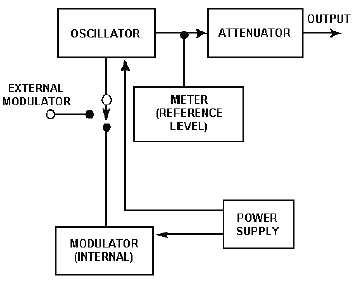5-10
RADIO-FREQUENCY (RF) SIGNAL GENERATORS
In addition to the necessary power supply, a typical rf signal generator contains three other main
sections: an OSCILLATOR CIRCUIT, a MODULATOR, and an OUTPUT CONTROL CIRCUIT. The
modulator modulates the rf signal of the oscillator. In addition, most rf generators are provided with
connections through which an external source of modulation of any desired waveform can be applied to
the generated signal. Metal shielding surrounds the unit to prevent signals from the oscillator from
affecting the circuit under test.
Q-4. Name the three main sections of a typical rf signal generator.
A block diagram of a representative rf signal generator is shown in figure 5-7. The function of the
oscillator stage is to produce a signal that can be accurately set in frequency at any point within the range
of the generator. The type of oscillator circuit used depends on the range of frequencies for which the
generator is designed. In lower frequency rf signal generators, the oscillating circuit consists of one of a
group of coils combined with a variable capacitor. One of the coils is selected by the position of a range
selector switch that connects the coil to a capacitor to provide an inductance-capacitance circuit. The
inductive-capacitance circuit then has the correct range of resonant frequencies.
Figure 5-7.—Rf signal generator block diagram.
The function of the modulator is to produce an audio (or video) modulating signal that can be
superimposed on the rf signal produced by the oscillator. The modulating signal may be provided by an
audio oscillator within the generator. This is termed INTERNAL MODULATION. It may also be derived
from an external source. This is termed EXTERNAL MODULATION. In some signal generators, either
of these two methods of modulation can be employed. In addition, a means of disabling the modulator
section is available so that the pure, unmodulated signal from the oscillator can be used when desired.
Q-5. What is the function of the modulating circuit?
The type of modulation selected depends on the application of the particular signal generator. The
modulating signal may be a sine wave, a square wave, or pulses of varying duration. In some special
generators, provision is made for pulses over a wide range of repetition rates and widths.

